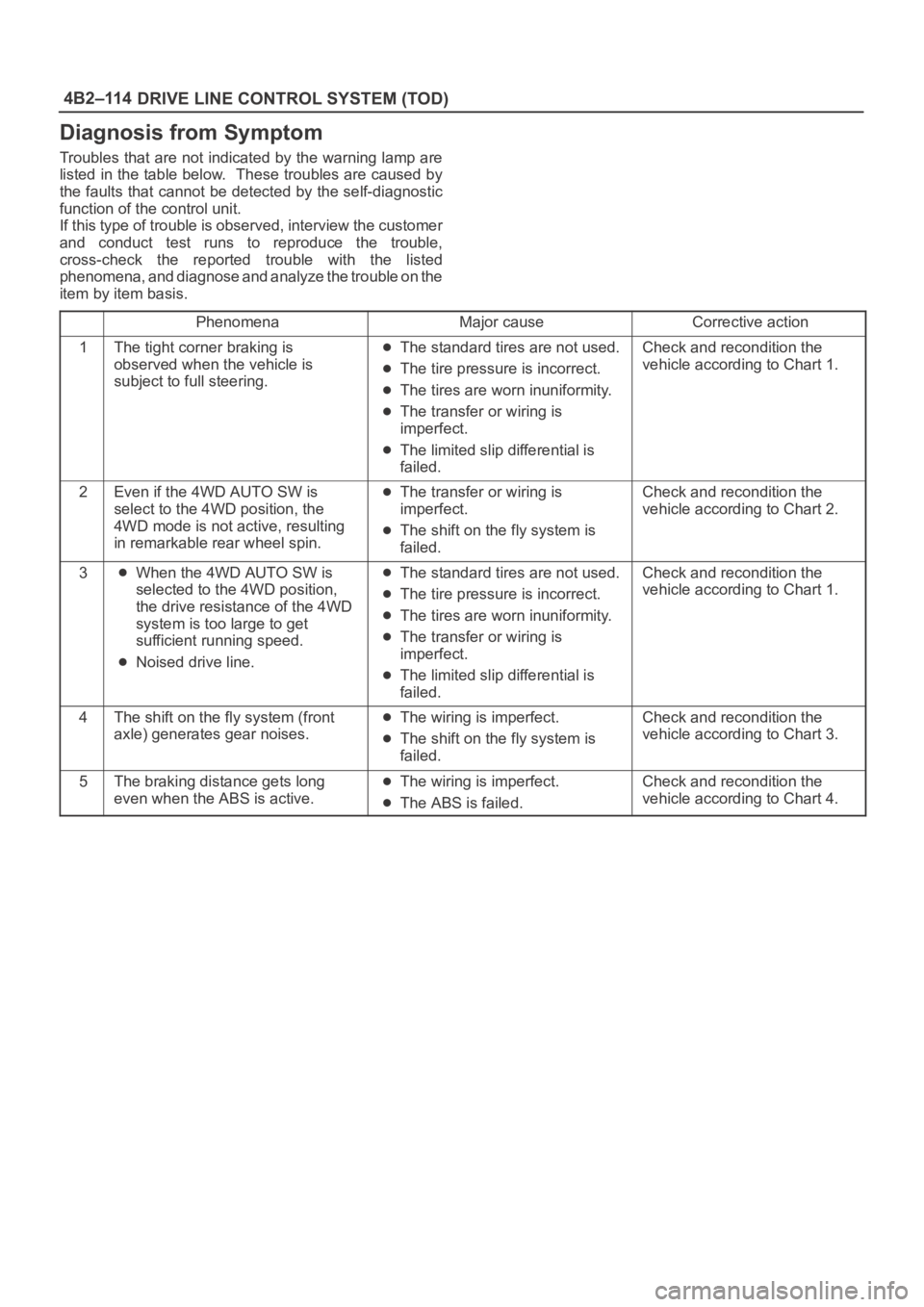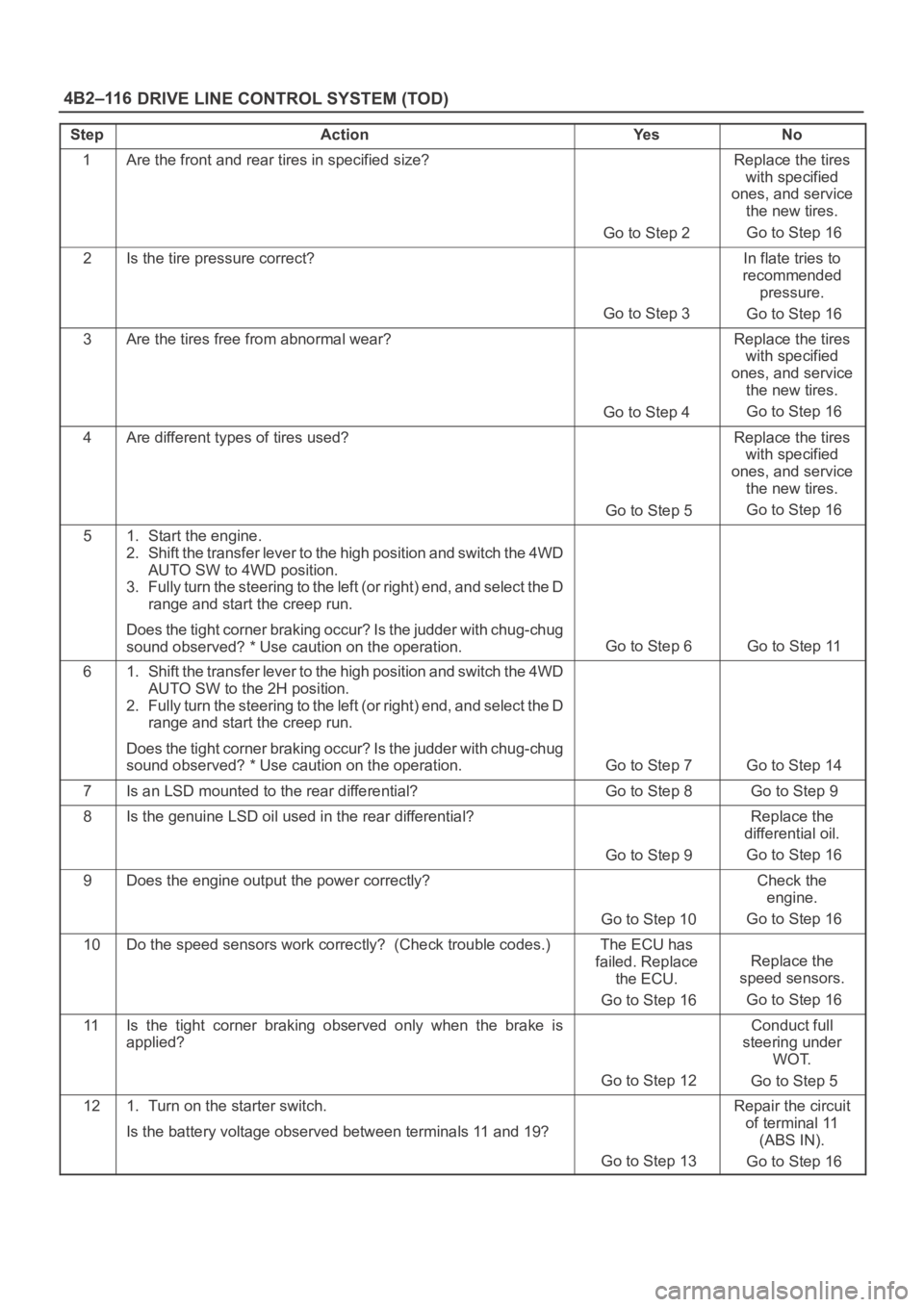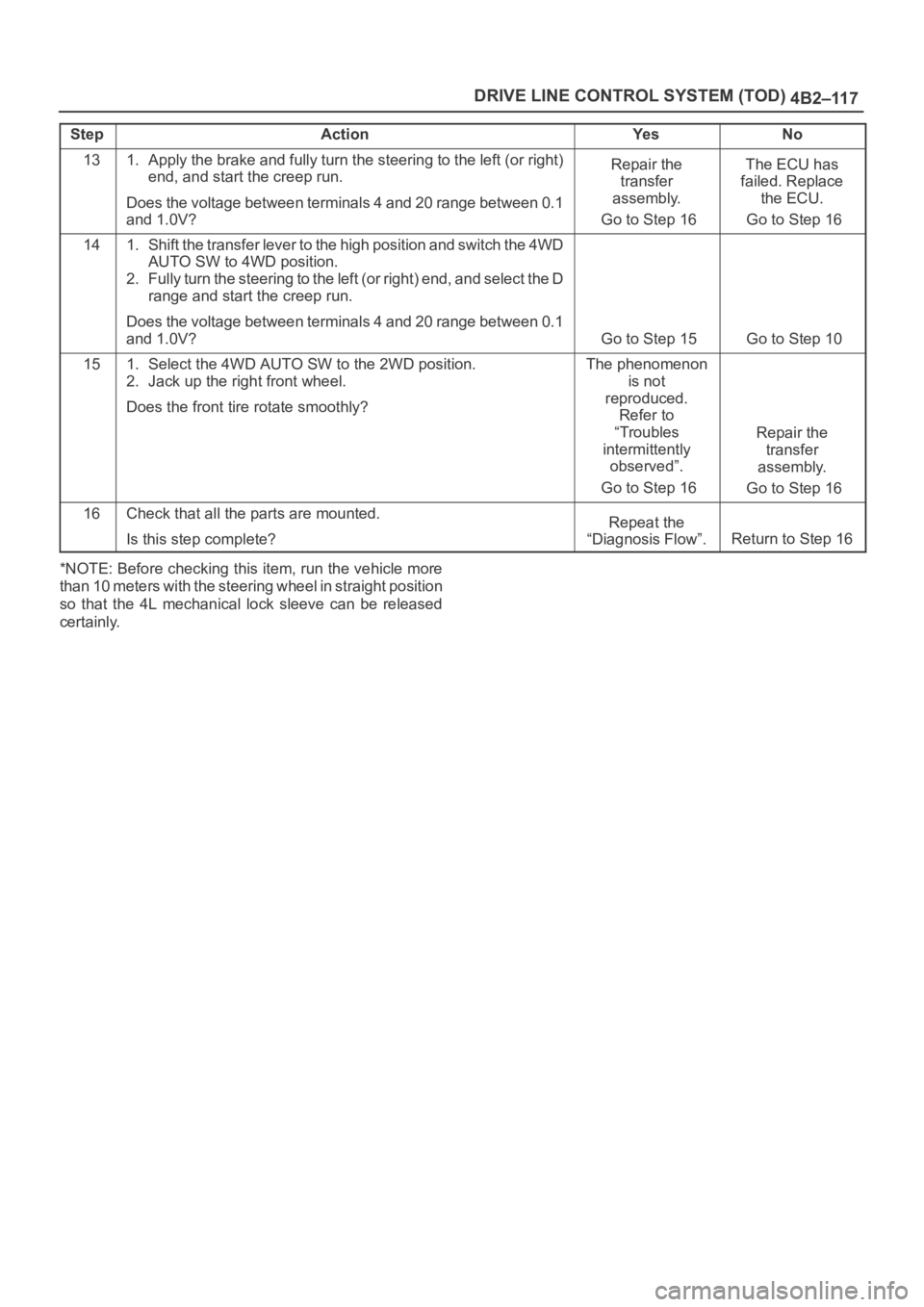Page 4186 of 6000
4B2–103 DRIVE LINE CONTROL SYSTEM (TOD)
StepNo Ye s Action
15When the transfer lever is shifted to the high position and 4WD
AUTO SW is selected to the 4WD position, is 0V observed on
each VSV?
Go to Step 16
Repair the circuit
or replace the
VSV.
Go to Step 19
16When the transfer lever is shifted to the 4L position, is 0V
observed on each VSV?
Go to Step 17
Repair the circuit
or replace the
VSV.
Go to Step 19
17Is the vacuum pressure supplied to the VSV?
Go to Step 18
Repair the
vacuum system.
Go to Step 19
18Can the single AXLE switch enable and disable the continuity?
Repair the shift
on the fly system
(refer to Section
4B1 and 4C.)
Replace the
AXLE switch
(refer to Section
4B1 and 4C of
Chassis Repair
Manual).
19Check that all the parts are mounted.
Is this step complete?Repeat the
“Diagnosis Flow”.
Return to Step 19
Page 4187 of 6000
DRIVE LINE CONTROL SYSTEM (TOD) 4B2–104
Chart E–2The AXLE switch circuit is short-circuited to GND.
Function of circuit—
Fail conditionEven after the 4WD AUTO SW is select to the 2WD position, the 2WD mode is not
enabled. (The transition status is not removed.)
Indicator lamp status
Transfer position2H
D04RY00068
Page 4191 of 6000

DRIVE LINE CONTROL SYSTEM (TOD) 4B2–108
StepActionYe sNo
1Start the engine.
When the transfer lever is shifted to the neutral position between
high and 4L, is 5V observed between terminals 10 and 19?
Go to Step 2Go to Step 7
2When the transfer lever is shifted to the high position and 4WD
AUTO SW is selected to the 4WD position, is 0V observed
between terminals 10 and 19?
Go to Step 3Go to Step 7
3When the transfer lever is shifted to the 4L position, is 0V
observed between terminals 10 and 19?
Go to Step 4Go to Step 7
4Select the 4WD AUTO SW to the 2WD position.
Is 12V observed between terminals 25 and 19?
Go to Step 5
Replace the
ECU.
Go to Step 19
5Is 12V observed between terminals 26 and 19?
Go to Step 6
Replace the
ECU.
Go to Step 19
6Is 12V observed between terminals 27 and 19?The phenomenon
is not
reproduced.
Refer to
“Troubles
intermittently
observed”.
The ECU has
failed. Replace
the ECU.
Go to Step 19
7When the 4WD AUTO SW is selected to the 2WD position, is the
battery voltage observed between terminals 5 and 19?
Go to Step 8Go to Step 11
8When the transfer lever is shifted to the neutral position between
high and 4L, is the battery voltage observed between terminals 5
and 19?
Go to Step 9Go to Step 11
9When the transfer lever is shifted to the high position and 4WD
AUTO SW is selected to the 4WD position, is 0V observed
between terminals (B–67)5 and (B–67)11?
Go to Step 10Go to Step 11
10When the transfer lever is shifted to the 4L position, is 0V
observed between terminals 5 and 19?
Go to Step 12Go to Step 11
11Is any of the trouble codes 28, 32 and 33 recorded?Examine the
trouble based on
“Diagnosis from
Trouble Codes”.
The ECU has
failed. Replace
the ECU.
121. Turn off the starter switch.
2. Disconnect the ECU connector.
Does the resistance between terminals 5 and 19 meet the
standard, 17< R < 25 ohm?
Go to Step 13
Repair the circuit
or replace the
VSV.
Go to Step 19
131. Connect the ECU connector.
2. Turn on the starter switch.
When the 4WD AUTO SW is selected to the 2WD position, is the
battery voltage supplied to each VSV?
Go to Step 14
Repair the circuit
or replace the
VSV.
Go to Step 19
14When the transfer lever is shifted to the neutral position between
high and 4L, is the battery voltage supplied to each VSV?
Go to Step 15
Repair the circuit
or replace the
VSV.
Go to Step 19
15When the transfer lever is shifted to the high position and 4WD
AUTO SW is selected to the 4WD position, is 0V observed on
each VSV?
Go to Step 16
Repair the circuit
or replace the
VSV.
Go to Step 19
Page 4197 of 6000

DRIVE LINE CONTROL SYSTEM (TOD) 4B2–114
Diagnosis from Symptom
Troubles that are not indicated by the warning lamp are
listed in the table below. These troubles are caused by
the faults that cannot be detected by the self-diagnostic
function of the control unit.
If this type of trouble is observed, interview the customer
and conduct test runs to reproduce the trouble,
cross-check the reported trouble with the listed
phenomena, and diagnose and analyze the trouble on the
item by item basis.
PhenomenaMajor causeCorrective action
1The tight corner braking is
observed when the vehicle is
subject to full steering.The standard tires are not used.
The tire pressure is incorrect.
The tires are worn inuniformity.
The transfer or wiring is
imperfect.
The limited slip differential is
failed.
Check and recondition the
vehicle according to Chart 1.
2Even if the 4WD AUTO SW is
select to the 4WD position, the
4WD mode is not active, resulting
in remarkable rear wheel spin.The transfer or wiring is
imperfect.
The shift on the fly system is
failed.
Check and recondition the
vehicle according to Chart 2.
3When the 4WD AUTO SW is
selected to the 4WD position,
the drive resistance of the 4WD
system is too large to get
sufficient running speed.
Noised drive line.
The standard tires are not used.
The tire pressure is incorrect.
The tires are worn inuniformity.
The transfer or wiring is
imperfect.
The limited slip differential is
failed.
Check and recondition the
vehicle according to Chart 1.
4The shift on the fly system (front
axle) generates gear noises.The wiring is imperfect.
The shift on the fly system is
failed.
Check and recondition the
vehicle according to Chart 3.
5The braking distance gets long
even when the ABS is active.The wiring is imperfect.
The ABS is failed.
Check and recondition the
vehicle according to Chart 4.
Page 4199 of 6000

DRIVE LINE CONTROL SYSTEM (TOD) 4B2–116
StepActionYe sNo
1Are the front and rear tires in specified size?
Go to Step 2
Replace the tires
with specified
ones, and service
the new tires.
Go to Step 16
2Is the tire pressure correct?
Go to Step 3
In flate tries to
recommended
pressure.
Go to Step 16
3Are the tires free from abnormal wear?
Go to Step 4
Replace the tires
with specified
ones, and service
the new tires.
Go to Step 16
4Are different types of tires used?
Go to Step 5
Replace the tires
with specified
ones, and service
the new tires.
Go to Step 16
51. Start the engine.
2. Shift the transfer lever to the high position and switch the 4WD
AUTO SW to 4WD position.
3. Fully turn the steering to the left (or right) end, and select the D
range and start the creep run.
Does the tight corner braking occur? Is the judder with chug-chug
sound observed? * Use caution on the operation.
Go to Step 6 Go to Step 11
61. Shift the transfer lever to the high position and switch the 4WD
AUTO SW to the 2H position.
2. Fully turn the steering to the left (or right) end, and select the D
range and start the creep run.
Does the tight corner braking occur? Is the judder with chug-chug
sound observed? * Use caution on the operation.
Go to Step 7 Go to Step 14
7Is an LSD mounted to the rear differential? Go to Step 8 Go to Step 9
8Is the genuine LSD oil used in the rear differential?
Go to Step 9
Replace the
differential oil.
Go to Step 16
9Does the engine output the power correctly?
Go to Step 10
Check the
engine.
Go to Step 16
10Do the speed sensors work correctly? (Check trouble codes.)The ECU has
failed. Replace
the ECU.
Go to Step 16
Replace the
speed sensors.
Go to Step 16
11Is the tight corner braking observed only when the brake is
applied?
Go to Step 12
Conduct full
steering under
WOT.
Go to Step 5
121. Turn on the starter switch.
Is the battery voltage observed between terminals 11 and 19?
Go to Step 13
Repair the circuit
of terminal 11
(ABS IN).
Go to Step 16
Page 4200 of 6000

4B2–117 DRIVE LINE CONTROL SYSTEM (TOD)
StepNo Ye s Action
131. Apply the brake and fully turn the steering to the left (or right)
end, and start the creep run.
Does the voltage between terminals 4 and 20 range between 0.1
and 1.0V?Repair the
transfer
assembly.
Go to Step 16The ECU has
failed. Replace
the ECU.
Go to Step 16
141. Shift the transfer lever to the high position and switch the 4WD
AUTO SW to 4WD position.
2. Fully turn the steering to the left (or right) end, and select the D
range and start the creep run.
Does the voltage between terminals 4 and 20 range between 0.1
and 1.0V?
Go to Step 15 Go to Step 10
151. Select the 4WD AUTO SW to the 2WD position.
2. Jack up the right front wheel.
Does the front tire rotate smoothly?The phenomenon
is not
reproduced.
Refer to
“Troubles
intermittently
observed”.
Go to Step 16
Repair the
transfer
assembly.
Go to Step 16
16Check that all the parts are mounted.
Is this step complete?Repeat the
“Diagnosis Flow”.
Return to Step 16
*NOTE: Before checking this item, run the vehicle more
than 10 meters with the steering wheel in straight position
so that the 4L mechanical lock sleeve can be released
certainly.
Page 4201 of 6000
DRIVE LINE CONTROL SYSTEM (TOD) 4B2–118
Chart 2The 4WD mode is not active.
Function of circuit—
Fail conditionThe rear wheels spin in the TOD mode, so the driving torque is not transmitted to the
front wheels. The indicator lamps will not show the 4L and TOD status.
D04RY00073
Page 4206 of 6000
DRIVE LINE CONTROL SYSTEM (TOD) 4B2–123
Step Action Yes No
1 Are the brake and ABS systems healthy?
Go to Step 2Repair the
brake and ABS.
Refer to
section 5A.
2 Turn on the star ter switch.
Is the battery voltage observed between terminals 1 and 20?
Go to Step 3Repair the
battery system.
Go to Step 4
3 1. Select the 4WD AUTO SW to the 2WD position.
2. The voltage between terminals 3 and 19 range between 7.5
and 16V (0.12 seconds make a cycle)
Does the voltage within the range specified? Go to Step 4The ECU has
failed. Replace
the ECU.
Go to Step 4
4 Check that all the par ts are mounted.
Is this step complete?Repeat the
“Diagnosis Flow". Return to Step 4